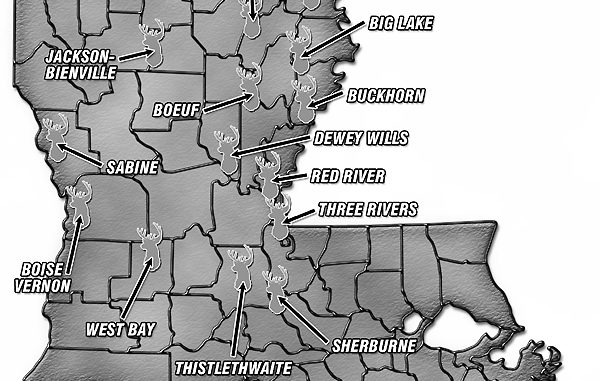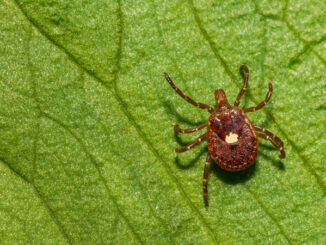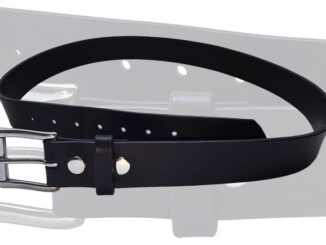
Some hunters feel like the season is winding down, but there may be no better time to score the buck of your dreams than right now.
Late December can be frustrating — even frightening — for a Louisiana deer hunter. I know because I’ve been there.
As exciting as it is to get a chance at a wall-hanger buck, most deer hunters are like me. While I want to be able to put a trophy mount on the wall, I also want to see my freezer stocked with backstrap, tenderloin, roasts and ground venison.
In other words, while I hunt deer for sport, I also hunt for food.
On more occasions than I care to recall, I have dug to the bottom of my freezer to locate the last package marked “venison backstrap” to cook for Christmas dinner. As I sit down to enjoy the last of the steaks from last season, I sometimes develop a case of indigestion in pondering what I’ll do over the long months between now and next October when the season opens again.
Venison is a very popular meat in Louisiana. I know hunters who take the legal limit of six deer per year, and they eat venison in some form practically every day. By summer, their freezers are bare, and they’re forced to settle for meats that in their minds rank far below prime venison — meats such as beef, pork and chicken.
I can’t offer anything to the six-deer-per-season consumers except to extend my condolences. Six is all you’re allowed, and I don’t condone exceeding the season bag limit. I suppose you’re just going to have to develop a taste for beef.
However, for the hunter who takes two to three deer per year and makes the venison last until next season, there may be something I can do to help you. I know it’s late in the season, but there are still some prime areas around the state where you have an excellent chance to put some venison in your freezer.
In fact, there are some areas around Louisiana where your best chance at a deer may be near the end of the season.
Here in Louisiana, our winters are generally mild, but occasionally, we do get cold weather. On rare occasions, we may even get to see a light dusting of snow on our rooftops. More likely, though, we’ll have the dreaded ice storm that can really do a number on our brittle pines, and this usually occurs during December and January.
When an ice storm hits, make sure the generator has gasoline, the pipes are wrapped and there is an ample wood supply for the fireplace. Once you have this taken care of, my suggestion is to head for your deer stand, especially one around a food plot. Chances are excellent that you’ll be skinning out a deer before sundown.
Not only might you have a fat doe walk into your sight picture, big bucks are also known to move about, especially when inclement weather is eminent.
I had this proven to me dramatically just before Christmas several years ago when an storm was in the process of encasing North Louisiana in a coating of ice. The roads were still open, so I drove down to my hunting lease late that afternoon to see if a deer might decide to visit my winter food plot.
The biggest buck I ever saw, a 140-class 8-point, stepped out, and his mount now graces my den wall. During that same storm, I heard of several other hunters who had similar success.
There is a reason for this, and deer hunters who realize what happens when a winter storm is approaching stand an excellent chance to collect their venison, with the prospects of taking a trophy buck not out of the question.
The buck I got that cold December afternoon is a good example. I had hunted that stand all season long, and had seen very few deer.
However, once the gathering storm was a certainty, the big buck no doubt wanted to fill his belly with the lush green clover that I had planted and then retreat to the thickets to ride out the storm. Ordinarily, he would have fed on the plot under the cover of darkness, but the impending ice storm left him no option except to risk exposure while he grazed.
For me, it was simply being in the right place at the right time.
The lesson deer hunters should learn here is quite simple. Deer move about and feed heavily with the approach of cold, icy weather. Thus, hunters should be on stand over green fields under these conditions.
Another reason for hunting food plots in late season is that most of the forage in the woods has either been eaten or has succumbed to freezing weather. Winter wheat, oats and clover offer a cold-weather bonanza when natural food sources are gone.
Now that we know that stocking your freezer with prime venison is still a possibility, let’s look at some areas around the state where you might have your best chance to take a late-season deer.
Hunters can utilize a variety of methods to hunt late-season deer. Louisiana’s archery season begins over most of the state on Oct. 1 and continues through Jan. 31. Not all portions of the state have this liberal season, so it’s important to check hunting season dates and regulations for the areas you plan to bowhunt.
Muzzleloader hunters, in general, get the week before regular gun season opens and the week after gun season closes to try their sport. This extends the season for hunters who still haven’t collected their venison. Also, some impressive trophy bucks are taken each season by black-powder hunters during cold winter months.
Gun hunters who like to go it alone have weeks of prime hunting available during portions of November and December during the still hunt-only portion of the season. (Check regulations for dates in your area.)
Louisiana deer hunters are blessed because there are thousands of acres of public land from one end of the state to the other where late-season deer hunters can go for a chance at venison on the table or a mount for the wall.
Here are some of the state’s top public areas where good deer hunting takes place during he waning weeks of hunting season.
District 1
Located within the Minden-based district is one of the state’s prime areas for taking a deer. It’s the Jackson-Bienville Wildlife Management Area, a 32,000-acre mixed pine and hardwood tract owned by Weyerhaeuser Company.
As a result of the land being owned by a timber company, active forestry operations are ongoing, which means there are perpetual clear cuts and thinned areas that produce tons of succulent deer forage. Highline rights of way are planted in cool-season foods that provide a smorgasbord for deer, even during the coldest weather.
For more information, contact Steve Hebert at 318-371-3050.
District 2
Two of the top deer hunting areas in this district, based in Monroe, are Russell Sage and Bayou Macon wildlife management areas. According to Jimmy Anthony, wildlife biologist for the office based in Monroe, Bayou Macon is the better of the two.
“Bayou Macon, consisting of 6,940 acres and located in East Carroll Parish, has had intensive deer management going on, and there is a very good adult buck population here. Our harvest is real close to being one-to-one, bucks to does. During the muzzleloader season, there is usually not too much pressure, and there are some real trophies out there,” said Anthony.
“Also, the rut here is in mid to late December, so late-season hunters have a chance to hunt during some pre-rut activity.”
For more information, call Supervisor Jerald Owens at 318-362-3160.
District 3
Headquartered in Pineville, District 3 offers good late-season hunting on at least three management areas, according to District Supervisor C.R. Newland.
“The Sabine Wildlife Management Area consists of 14,780 acres, and is a real popular place to hunt during the Thanksgiving holidays. As a result, deer can be a bit spooky later in the season. However, a secondary rut involving does that were not bred earlier could be in progress during this time, so hunters could see some bucks chasing does,” said Newland.
“This area is not located near urban areas, so hunting pressure during December is not usually too high. There is the real potential to take a doe or a trophy buck here during December, and hunters should give it a try.”
Dewey Wills Wildlife Management Area is a 60,000-acre tract located in LaSalle and Catahoula parishes. Consisting of hardwood bottomlands with rich soils, the WMA surrenders some really big-bodies bucks every year.
“Hunters have a legitimate chance at a 250- to 300-pound buck here. However, since it’s near Alexandria, it gets hunted pretty hard, so the deer will be extra-cautious during December,” Newland added.
For more information, contact C.R. Newland at 318-487-5885.
District 4
This district is home to more than 200,000 contiguous acres of prime deer habitat, and as a result, is a popular place to deer hunt during late season.
Prime wildlife management areas such as Big Lake, Boeuf, Buckhorn, Red River and Three Rivers, plus the Tensas and Cocodrie national wildlife refuges, are all in the area offering top-notch deer hunting.
“These areas cover a lot of ground from Caldwell Parish to Concordia and on up to Tensas,” said Reggie Wycoff, district supervisor. “These areas have been under good deer management for a long time. Deer herds are at or near carrying capacity, so the chances of seeing deer are quite good.”
For more information, contact Reggie Wycoff at 318-757-4571. For information on Tensas, contact George Chandler at 318-574-2664. The contact for Cocodrie is Jerome Ford at 318-336-7119.
District 5
The southwest portion of the state is not known for top deer hunting. Around the state, District 5 is probably the least productive of all. However, according to District Supervisor John Robinette, two management areas are probably deserving of consideration.
“West Bay WMA is located in Allen Parish, and consists of 62,115 acres. West of it in Vernon Parish is Boise-Vernon WMA with 54,269 acres. It’s hard hunting here because there is usually a lot of pressure during the early gun season, especially during Thanksgiving. The rut is over, and you have to hunt trails, feeding or bedding areas to stand a chance at bagging a deer during late season,” said Robinette.
For more information, contact John Robinette, 337-491-2575.
District 6
Located in South Louisiana with headquarters in Opelousas, District 6 takes in a lot of the state’s thickest and most swampy areas. However, it is home to a healthy deer population, including some of the state’s most impressive bucks.
Two management areas here are simply outstanding — Sherburne and Thistlethwaite.
District Supervisor Kerney Sonnier oversees this district, and agrees that Sherburne and Thistlethwaite are two of the best WMAs in the state.
“Sherburne consists of 42,500 acres, and is a combination of bottomland hardwoods and cypress/tupelo gum swamp. Because of its location, Sherburne has lots of water, and in winter, water levels are usually high, making boat access necessary for much of the area.
“If you don’t mind the rough terrain, this area holds lots of deer, both in numbers and quality. It’s not unusual to score bucks coming off this area in the 150-160 class,” said Sonnier.
Thistlethwaite contains 11,000 acres, and is located in St. Landry Parish.
“This is another area with numbers of deer along with some good quality,” he said. “One thing that makes this area so good is there is hardly ever a mast failure. There are seven different species of oaks on Thistlethwaite, and some of them produce mast every year. You’ll just have to scout and find which trees are producing.
“Timber management is good, and as a result, there is seldom a lack of browse.
“The drawback on both these areas is the terrain, which can be challenging. However, with the deer we have here, it’s well worth the effort.
“The rut occurs in late December, so this time of year is a perfect time to find a good buck.”
For more information, contact Kerney Sonnier at 337-948-0255.
District 7
Although there are several quality deer hunting public areas located within this district, you may have to wait until next season to give this region a try. As a result of devastation caused by Hurricane Katrina, much of the area will be closed to deer hunting this season.


